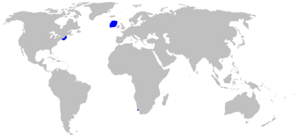Ghost catshark facts for kids
Quick facts for kids Ghost catshark |
|
|---|---|
 |
|
| Conservation status | |
| Scientific classification | |
| Genus: |
Apristurus
|
| Species: |
manis
|
 |
|
The ghost catshark (Apristurus manis) is a type of catshark. It belongs to the Scyliorhinidae family. This shark lives deep in the ocean, usually on the continental slopes. You can find it in the northwest Atlantic Ocean near Massachusetts. It also lives in the northeast Atlantic, off Ireland, and in the southern Atlantic near Cape Town. These sharks live very deep, from about 600 to 1900 meters (2,000 to 6,200 feet) below the surface.
Contents
What Does a Ghost Catshark Look Like?
The ghost catshark can grow quite long. It can reach up to 85 centimeters (about 33 inches) in length. Female ghost catsharks are ready to have babies when they are about 75 centimeters (about 30 inches) long.
Where Do Ghost Catsharks Live?
The ghost catshark is a demersal species. This means it lives near the seabed in deep ocean waters. You can find it in the Atlantic Ocean, mainly between 40° and 60° North.
It lives on the continental slopes. This includes areas off Massachusetts in the United States. It also lives near the Porcupine Bank west of Ireland. There have been reports of this shark living near Cape Town in South Africa too.
Ghost Catshark Reproduction
The ghost catshark reproduces by laying eggs. This is called being oviparous. The female shark lays her eggs in pairs. The young sharks grow inside these eggs. They get all their food from the egg yolk until they hatch.
How Are Ghost Catsharks Doing?
Scientists do not know much about the ghost catshark. This is because it lives in very deep water. Sometimes, research ships catch them by accident.
These sharks usually live deeper than where most fishing happens. However, they can sometimes be caught as bycatch. This means they are caught unintentionally during deep-water trawling. There is a chance that deep-water fishing might grow in the future. If it does, it could threaten the ghost catshark.
For now, the International Union for Conservation of Nature (IUCN) has listed the ghost catshark as a species of "least concern". This means they are not currently in danger.


